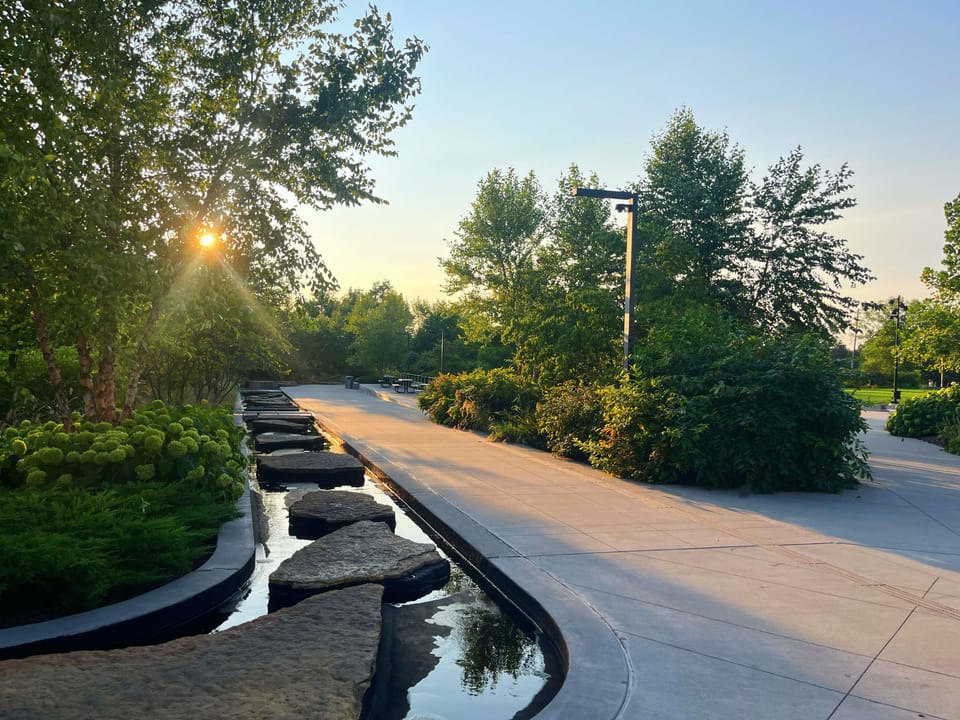What are bioswales? These 'ancient' landscape technologies might be underutilized in Fort Wayne

You've probably seen them, but you might not realize what they are – or the important role they play in the local ecosystem.
Bioswales, or living plant-based swales, are water-saving features in landscape architecture that captured our attention a few weeks ago when Brett Bloom, Founder of Dirt Wain (the city's only local, large-scale composting company), said these "ancient technologies" could be incorporated more often to ecologically enhance and beautify our city. He even suggested they might be a more effective – and cost-friendly – means of managing the city's stormwater overflow than the $188 million Deep Rock Tunnel (MaMaJo).
A few weeks after that conversation, Parks and Recreation's Superintendent of Landscape & Horticulture, Eric Ummel, happened to be leading a tour of a bioswale at Promenade Park.
We sat down with Ummel to learn more about the benefits of bioswales, how they work and where you can find – or build – them in Fort Wayne.

Tell us more about your background and your role in Parks.
EU: My background is in native plants and ecological restoration. I worked for an ecological restoration company with a native plant nursery for close to 18 years before I started working at the Parks department. About eight years ago, an opportunity there came up, and I was hired as Landscape Supervisor. Just recently this year, I was promoted to Landscape and Horticulture Superintendent, so now I’ve got not only landscape maintenance crews under me, but also our greenhouse staff, as well as our riparian division, out on the barge, working on invasive species along the riverbanks, and things like that. It’s been a lot of fun, and it’s allowed me to apply a lot of the skills I’ve learned in the past to what we’re doing in Parks.
For those who aren’t familiar, how would you explain a bioswale?
EU: A bioswale, in its simplest form, is a living swale (or shallow channel used to collect and/or move water and also remove pollution from it). A swale filled with native fieldstone is not a bioswale because it’s not “living.” The “living” side in a plant-driven bioswale can be any type of plant, but generally native plants. So a bioswale can refer to a swale with turf grass, but native plants function at a higher level than turf at retaining and filtering water.
Even within native plant bioswales, they can range in complexity and effectiveness. They can be simple as adding plants to a swale, or more complicated, like the bioswales we have at Promenade Park, where the top layer of soil is native plants, then below that there’s a layer of well-draining soil that acts as an aggregate with a perforated drain underneath, ultimately directing water back out to the river.
So the concept is: water and drainage come into swale met with native plants that have deep root systems, which immediately slow down the water. That top layer of plants is picking up sediment and debris from the plaza and sidewalks and also starting to absorb some of those pollutants, like nitrogen and phosphorus. Having plants slow the pace of the water allows it to percolate into the soil below, where we’ve got a nice, well-drained mixture of sandy, loamy soil, which creates crevices where the water is able to hide out and be stored, slowing it even further. In this soil layer, the deep native plant roots continue to filter and remove pollutants from the water, and as a result, a lot of the water that comes into the bioswale doesn’t get a chance to come out of it, which reduces flooding. The water that does trickle down and come out then has time to percolate back into the natural groundwater and aquaphor systems through the soil layer, and whatever water is left ends up in the perforated drain tile and gets sent back into the St. Marys River, in Promenade Park’s case. It’s important to note that of the natural filtration improves the water’s quality, as well.
Something I pointed out on our recent tour of the bioswales at Promenade Park is: when you look at the diameter of the pipe coming out of them, it is about 4-5 inches in diameter, and you’d think that with all the water that goes into those swales during a storm, that pipe might be larger. So I think the size of the pipe is a testament to how much water the bioswale is absorbing and that it’s working.

Where can we find bioswales in Fort Wayne, and why aren’t they talked about or utilized in developments more often, as opposed to other methods of drainage?
EU: The city’s Right of Way department has done several bioswales in street medians across Fort Wayne. A few that come to mind are colorful ones at Maysville Road and Stellhorn and at Maplecrest Road and Vance Avenue – both of which are full of flowers and native grasses.
Within Parks, a few bioswales that come to mind are Promenade Park (on both sides of the boardwalk near the entrance and along the kid’s creek) and Riverfront 2A’s new park, linking Promenade Park to Headwaters Park.
There’s also one at Solomon Farms – a more typical swale with native plants. There are some really awesome bioswales that are maybe 12-15-years-old at Buckner Park, too. Those are in the parking lots, and they’re full of mature, native plants and wildflowers.
Overall, I’m not sure why bioswales aren’t talked about or utilized more often in Fort Wayne. Some of it could be a lack of knowledge about their benefits, and some of it could be space limitations on certain developments. (For instance, straight pipes for drainage and stormwater take up less space.) But with a bioswale, what you’re creating works very much like a rain garden. They essentially do the same things, which is water detention. Detention ponds are also a way to slow down floodwaters. Again, with native plant bioswales, you’re getting more filtration, but these are all ways to clean up stormwater a bit and reduce flooding.
To clarify, what’s the difference between a bioswale and a rain garden?
EU: They do the same thing. But the main difference is bioswales transport water from point A to point B. Rain gardens operate more as a detention basin, where water goes into a shallow pool or pond, and the plants there, as in the bioswale, filter that water. But both rain gardens and bioswales can help improve stormwater management in the city.

We’ve heard that the use of more bioswales in Fort Wayne could reduce the need for costly, more drastic measures, like the deep rock tunnel, MamaJo. Is that correct?
EU: Bioswales, rain gardens and the like can all make a difference in the city’s stormwater management. And while you can always advocate for more bioswales in developments, you can also make a difference right where you live because there are a lot of impervious surfaces at our houses – like roofs, driveways and sidewalks. In fact, City Utilities even offers a matching credit of $250 for people who add rain gardens to their homes as part of its Catching Rain initiative, which is worth exploring.
If we all took a little responsibility and kept a little bit of that stormwater on-site by storing it in a bioswale or rain garden, we could make a pretty big dent in the amount of flooding and stormwater runoff in Fort Wayne.
